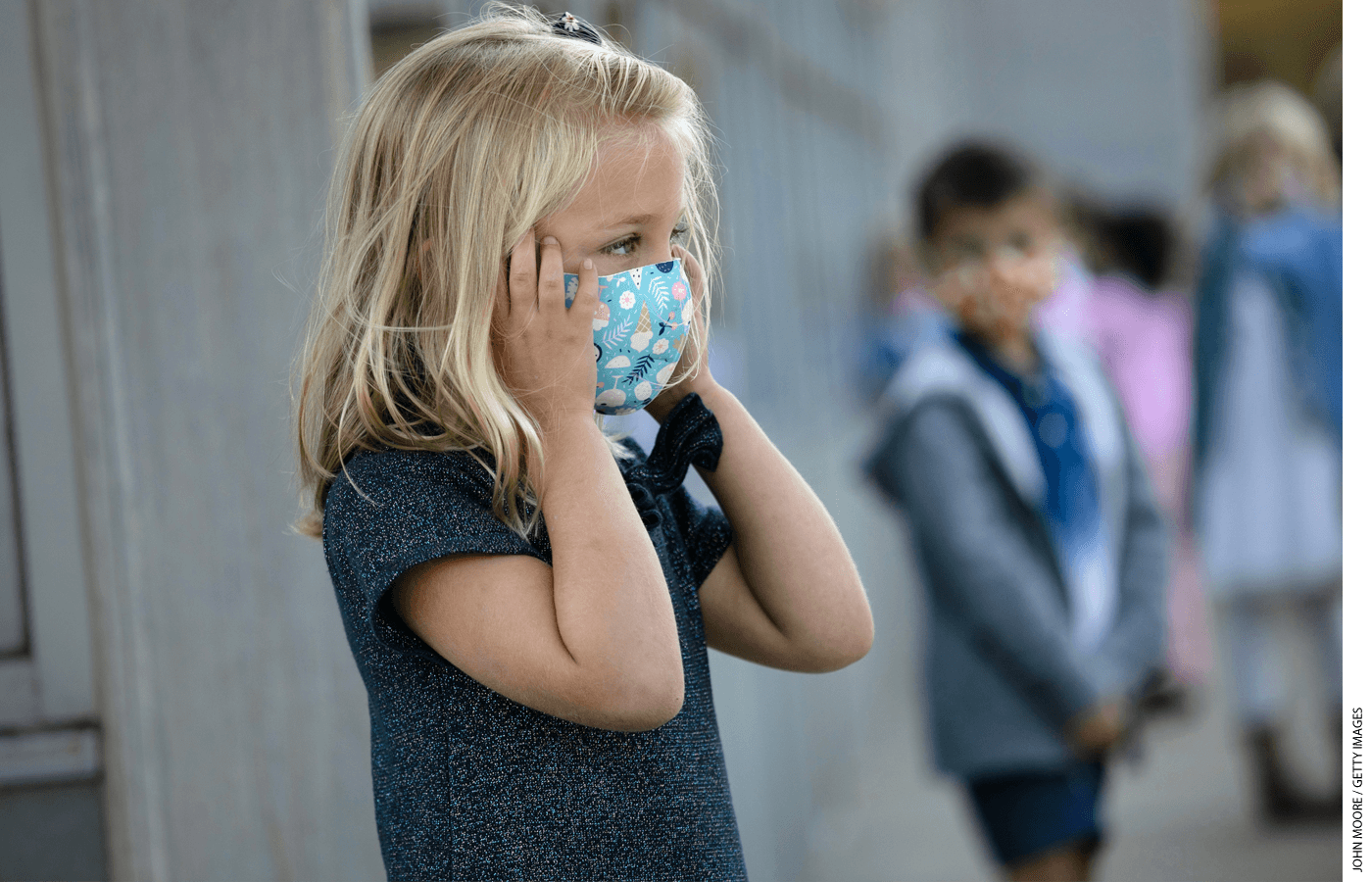
The 15th annual Education Next survey, conducted in June 2021, yields a host of specific results that reveal one large fact about the current state of public opinion on American education: The public is cautious—extremely cautious. In the presence of a still-circulating Covid-19 virus, a large percentage of parents and the broader public want schools to take strong measures to keep children safe as they return to school. Yet many parents are not ready to risk the injection of a Covid vaccine into their child’s arm, even as government agencies testify to its safety and effectiveness.
In this article, we report on the 2021 follow-up survey to polls of parents of school-age children that we administered in May and November 2020, enabling us to track children’s schooling experiences over the course of the pandemic. In late May and June—at the tail end of what was surely the most unusual school year in our nation’s history—we interviewed a representative sample of 2,022 parents with children in kindergarten through 12th grade. Every parent then answered a series of questions about each of their children. We oversampled Black and Hispanic parents, as well as parents with children in private and charter schools, which allows us to make more-precise comparisons between racial and ethnic groups and between school sectors. In addition to reporting on their children’s schooling experiences, parents answered some of the questions included in our parallel survey of a nationally representative sample of adults, the results of which are discussed more fully in a companion article that also provides details on the methods for each survey (see “Hunger for Stability Quells Appetite for Change”).
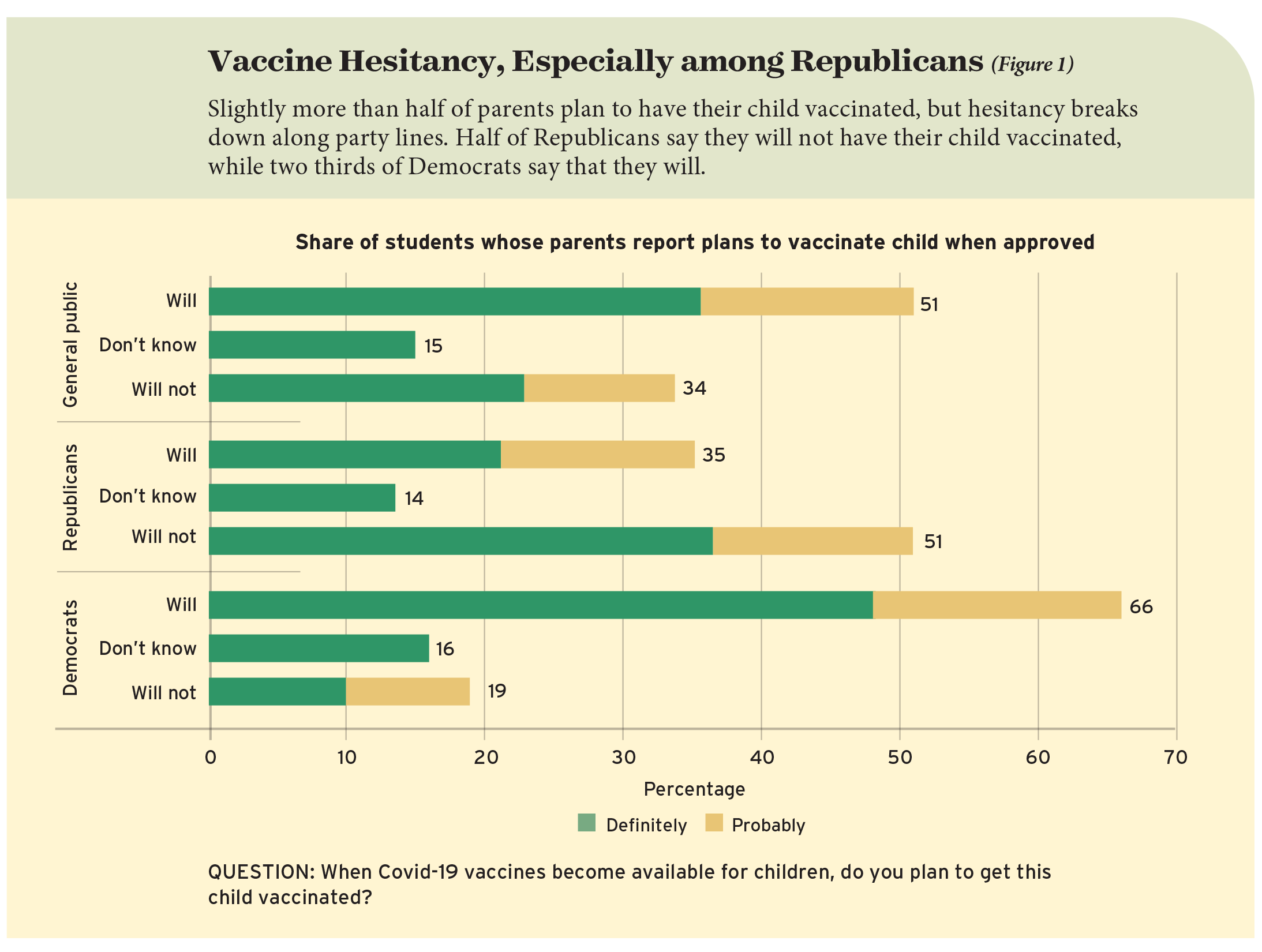
Vaccine Hesitancy
We asked our nationally representative sample of parents whether they planned to have each of their school-age children vaccinated “when Covid-19 vaccines become available for children.” At the time we fielded our survey in early June, the Federal Drug Administration had recently approved the use of the vaccine for children aged 12–17, but not for those 11 and younger.
Parents of a bare majority of children under the age of 18 (51%) say they “probably” or “definitely” would have their child vaccinated (see Figure 1). The parents of another third (34%) say they “probably” or “definitely” would not. The parents of 15% of children say they don’t know. If these sentiments expressed in June 2021 remain stable, the road to universal vaccination will be bumpy.
Parental plans are influenced by the age of the child. Though the data aren’t yet definitive, some public health officials have said that younger children seem to be less likely than older ones to contract a Covid infection, and that if they do, they are less likely to have a serious illness. For children in elementary school, the percentage whose parents expect to have their child vaccinated is less than half (46% for the youngest grades, 47% for older elementary school students). Older children are also unlikely to be seriously affected by the virus, especially when compared to those over the age of 65. About 6 out of 10 high school students (59%) are slated by their parents to receive vaccinations; 52% of middle school children (grades 6 to 8) have a parent who reports such plans.
With one exception, the responses do not differ much by school sector: 52% of children at district schools are likely to get the vaccine, as compared to 60% at charter schools and 54% of those attending private schools. However, those who report home-schooling their children are more hesitant. Unless parents change their views, 32% of home-schooled children will probably or definitely be vaccinated. Hispanic parents’ openness to vaccination is slightly greater than that of Black or white parents. The percentage of children for whom parents plan vaccinations is 56% for Hispanic children, 49% for Black children, and 47% for white children.
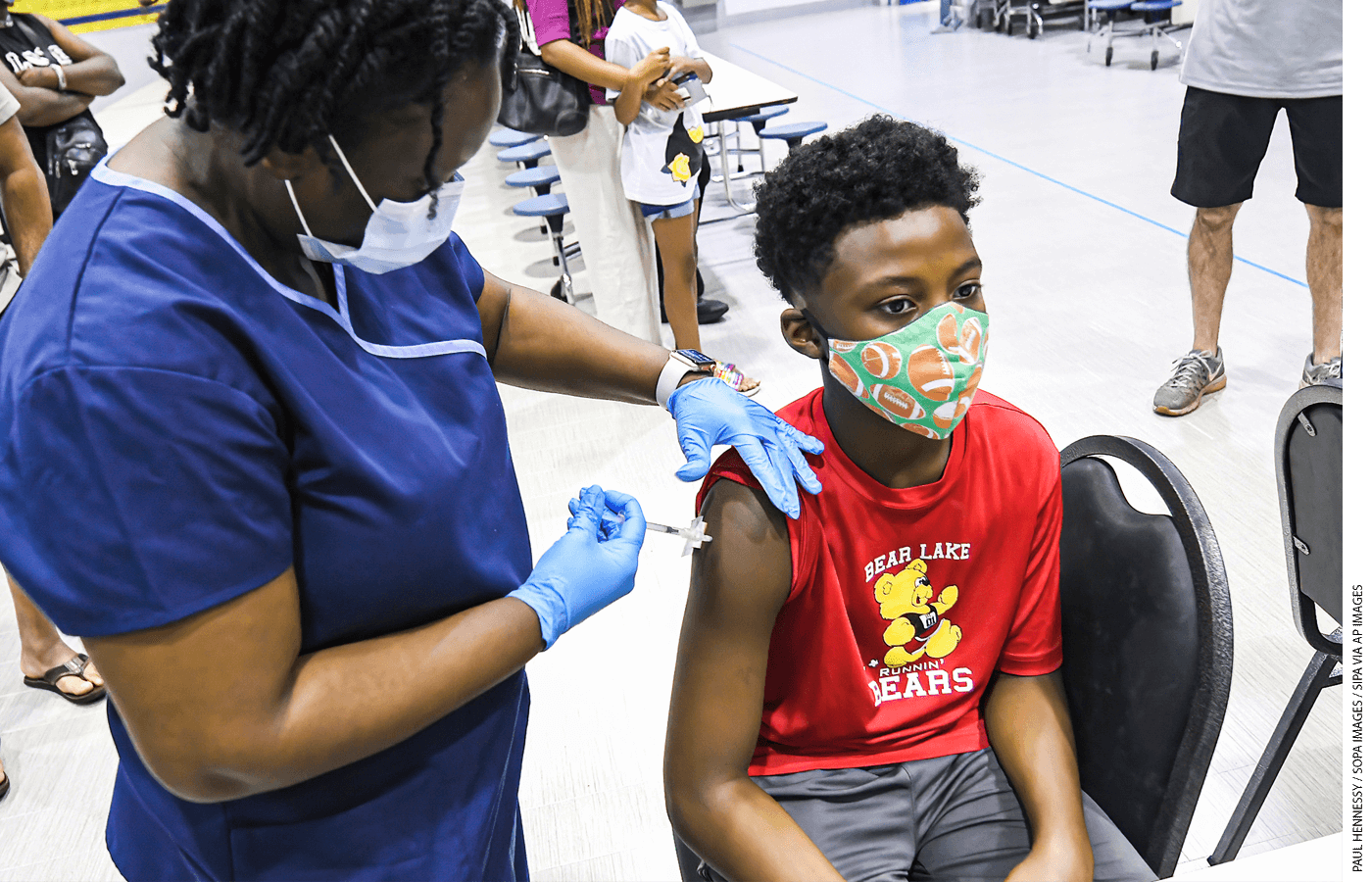
The major divide on the issue of child vaccination falls along party lines. Despite the fact that the Covid-19 vaccines were developed and approved for use in adults under President Donald Trump, Republicans are far less likely than Democrats to say that they will have their children vaccinated. For children whose parent identified as a Republican, the parents of a majority (51%) report that they definitely or probably will not have their child vaccinated; the parents of 35% say that they definitely or probably will. For children whose parent identified as a Democrat, those percentages are flipped. The parents of 66% of children say they will have their child vaccinated, while the parents of 18% say they will not.
In Short: Parents of about a third of children think the risks of vaccination outweigh the benefits for children, and another 15% of parents are unsure. Vaccine hesitancy is more pronounced for parents of younger children. With the exception of home-schooled children, differences across school sectors are small. Differences by political party, however, are quite large. Those who view universal vaccination as a prerequisite to a full reopening of American schools and the broader economy appear to be facing a serious challenge—especially in red states.
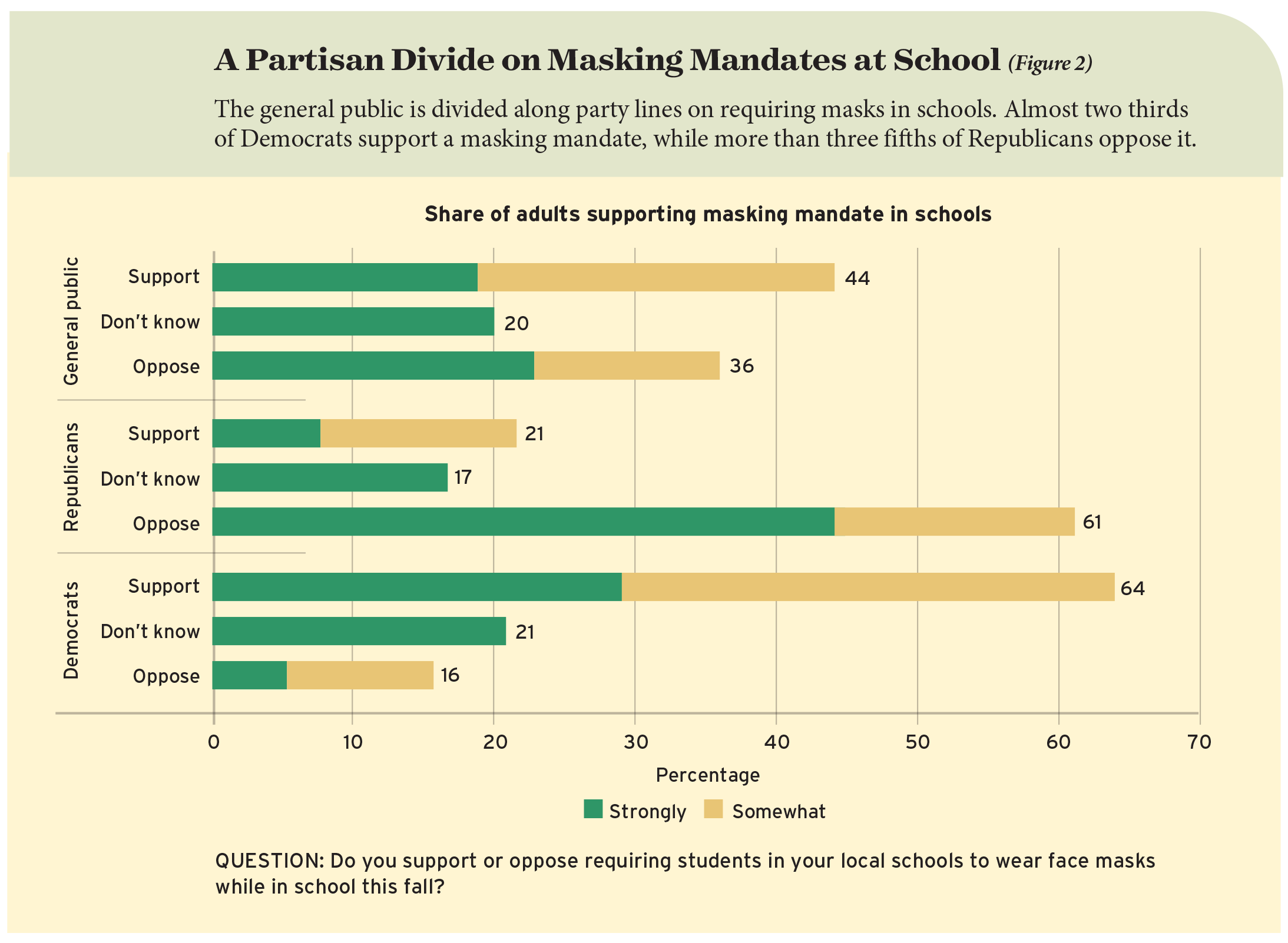
Safety First: Masking and Distancing in Schools
Many parents support measures to protect their children from infection at school even though some of the protections—masking and social distancing—could interfere with the learning process. Nearly half (47%) of parents favor requiring students to wear masks when schools open in the fall, and about a third (35%) oppose the practice, with the rest taking a neutral position. The views of the broader public largely mirror those of parents, with 44% favoring mask wearing and 36% opposed (see Figure 2).
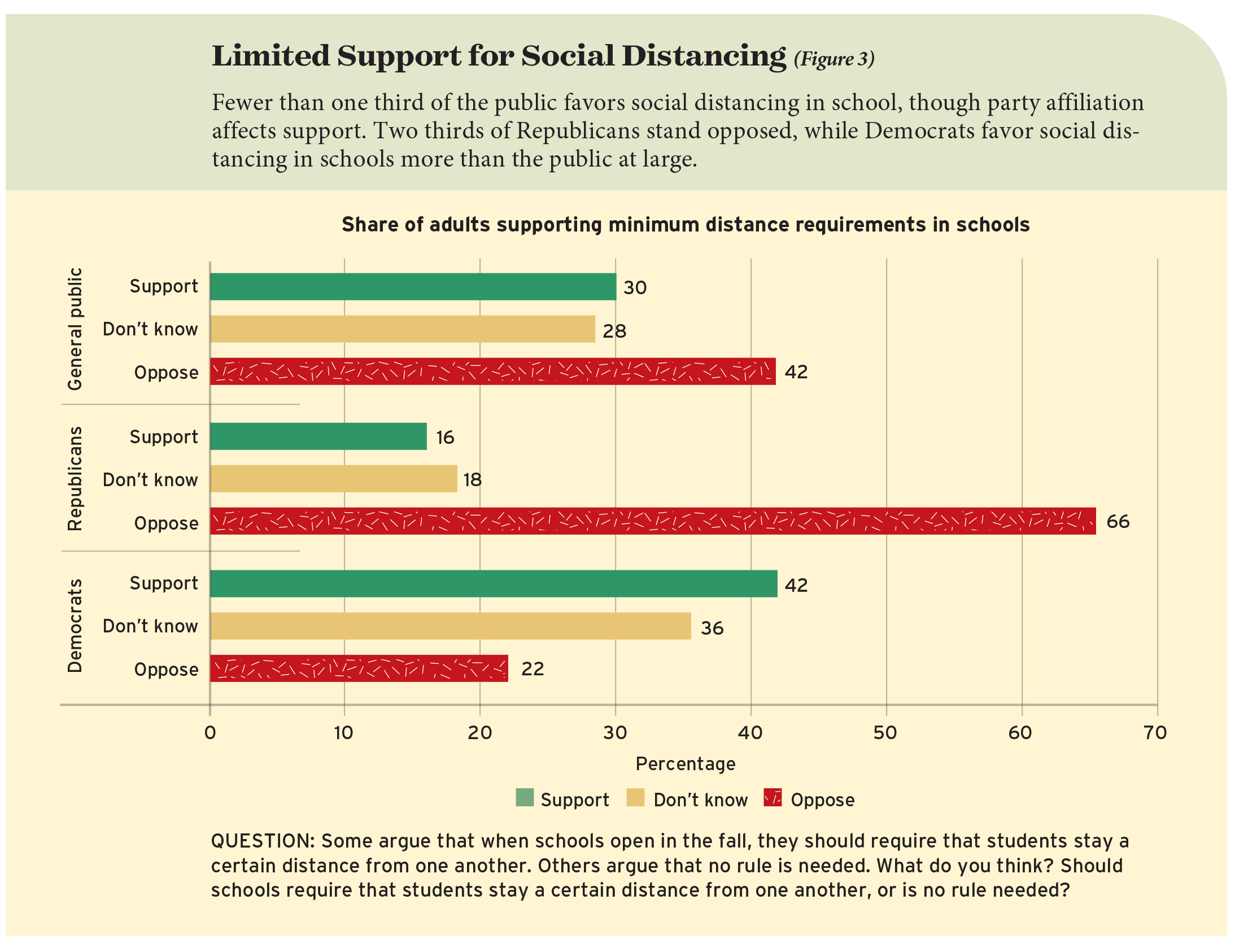
Parents are somewhat less supportive of social distancing at school, perhaps because they recognize that keeping children apart from one another is far from easy. Fewer than a third (32%) of parents think students should maintain a certain distance from one another, with 42% saying no such rule should be imposed; the rest say they are “not sure.” Among parents who support social distancing in schools, a slight majority of 54% say that students should be kept six feet apart, with 40% indicating that three feet or less would be appropriate. Once again, the views of the broader public on the issue of social distancing are very similar to those of parents (see Figure 3).
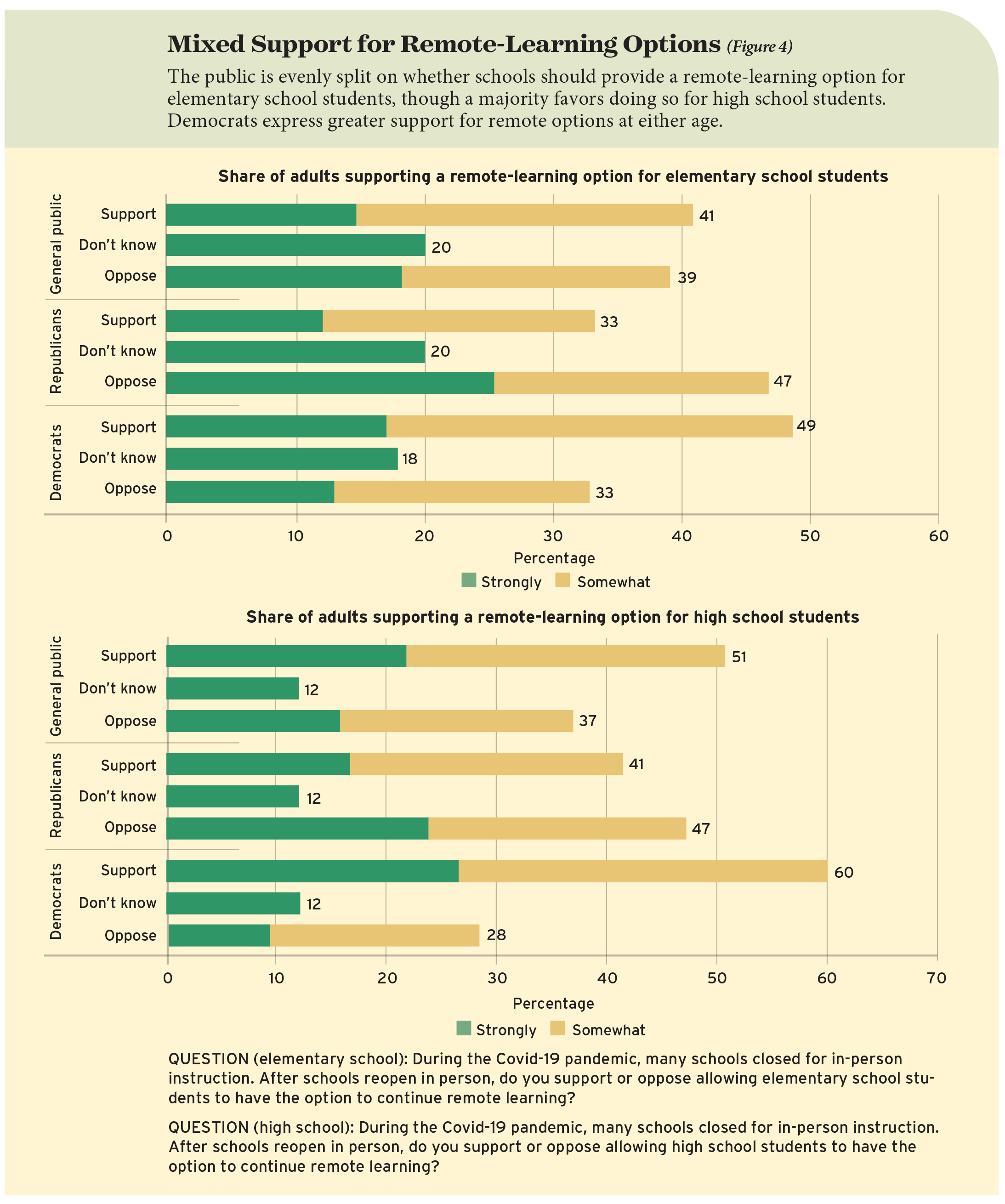
Parents also favor giving families the option of not sending their children to school this fall, in marked contrast to the historic practice of requiring in-school instruction unless a family is home-schooling. Nearly two thirds (64%) of parents say high school students should have the option of learning fully online, and nearly half (48%) say the same for elementary school students. The public as a whole is less enthusiastic about the prospect of permitting remote instruction, however, with 51% supporting a remote option for high school students and 41% endorsing that choice for elementary school students (see Figure 4).
Opinion on Covid-prevention measures divides sharply across party lines. Among Republicans, 21% approve of mask requirements, while 64% of Democrats do. When it comes to social distancing, nearly two thirds (66%) of Republicans oppose any minimum-distance mandate, as compared to 22% of Democrats. All high school students should have the option of learning online, according to 41% of Republicans and 60% of Democrats. The choice should be available for elementary school students, say 33% of Republicans, but 49% of Democrats.
A mask requirement is more popular in the minority community than among white adults. Sixty-nine percent of Black adults and 59% of Hispanic adults favor mandatory masking, but only 33% of white adults do. When it comes to social distancing at school, 51% of white adults say “no rule is needed,” but that position is taken by only 21% of Black adults and 32% of Hispanic adults. Conversely, 60% of Hispanic adults and 54% of Black adults favor providing students a remote-learning option, as compared to 46% of white adults.
In Short: The public remains fairly risk-averse about schools reopening. But caution is much more prevalent among Democrats than Republicans, showing once again how politicized the response to the pandemic has been. If school districts are responsive to social and political attitudes, one might expect school practices to vary widely across the country, depending on the racial and ethnic composition of the local populations and the partisan balance of power.
Parental Assessments
Parents report differences in the schooling situation between November 2020 and June 2021. By June, the parents of more than half (52%) of students say their child is going to school entirely in person rather than taking classes remotely (27%) or in a mix of the two formats (21%). Those percentages are the near reverse of those from November 2020, when 28% of children were going to school in person full time, 53% of them were attending school remotely, and the rest were learning in the hybrid format, according to their parents. March seemed to be the halfway point in the process of returning to in-person education. As of that month, 43% of students were said to be going to school fully in person, 35% were entirely remote, and 23% were experiencing a blend of both. In November 2020, parents reported a high incidence of adverse consequences for their children as a result of measures taken by schools to stem the spread of Covid-19. Children were suffering learning loss, impairment of academic instruction, social isolation, emotional distress, and inadequate physical exercise, parents said. Despite all of these reported problems, parents overwhelmingly indicated that they were satisfied with their children’s schools, suggesting that parents believed the schools were doing about as well as they could under the circumstances. Parents were more positive about a child’s experiences if the child was attending school in person rather than online and if the child was enrolled in a private rather than a district school.
Pandemic impacts. In our June 2021 survey, we asked parents several of the same questions about pandemic impacts that we also posed in November 2020. Parental responses to these questions are remarkably similar to those given earlier, despite the fact that disruption had continued for an additional eight months. What parents said about their children’s educational experience in November they continue to say the following June. Matters have not improved, according to parents, but neither have they worsened.
Despite the move toward in-person learning between November and June, parents’ assessments of Covid’s impacts on their children remain essentially unaltered. At the end of the school year, parents of 57% of the students say their child is learning somewhat or a lot less this school year than “they would have learned if there had not been a pandemic,” about the same as the 60% who gave this response the previous fall. The percentage of children perceived to be experiencing a somewhat negative or strongly negative impact on their “academic knowledge and skills” reached 39%, slightly (but not significantly) higher than earlier in the school year. Negative impacts on social relationships are observed for 49% of the children, hardly different from the 50% figure registered in November. The 41% of children for whom negative effects on emotional wellbeing are identified remains exactly the same in the two surveys. The percentage of children whose physical fitness has been adversely affected ticks downward from 45% to 42%, an insignificant change. Altogether, the data show parental assessments remain unchanged from November to the end of the school year.
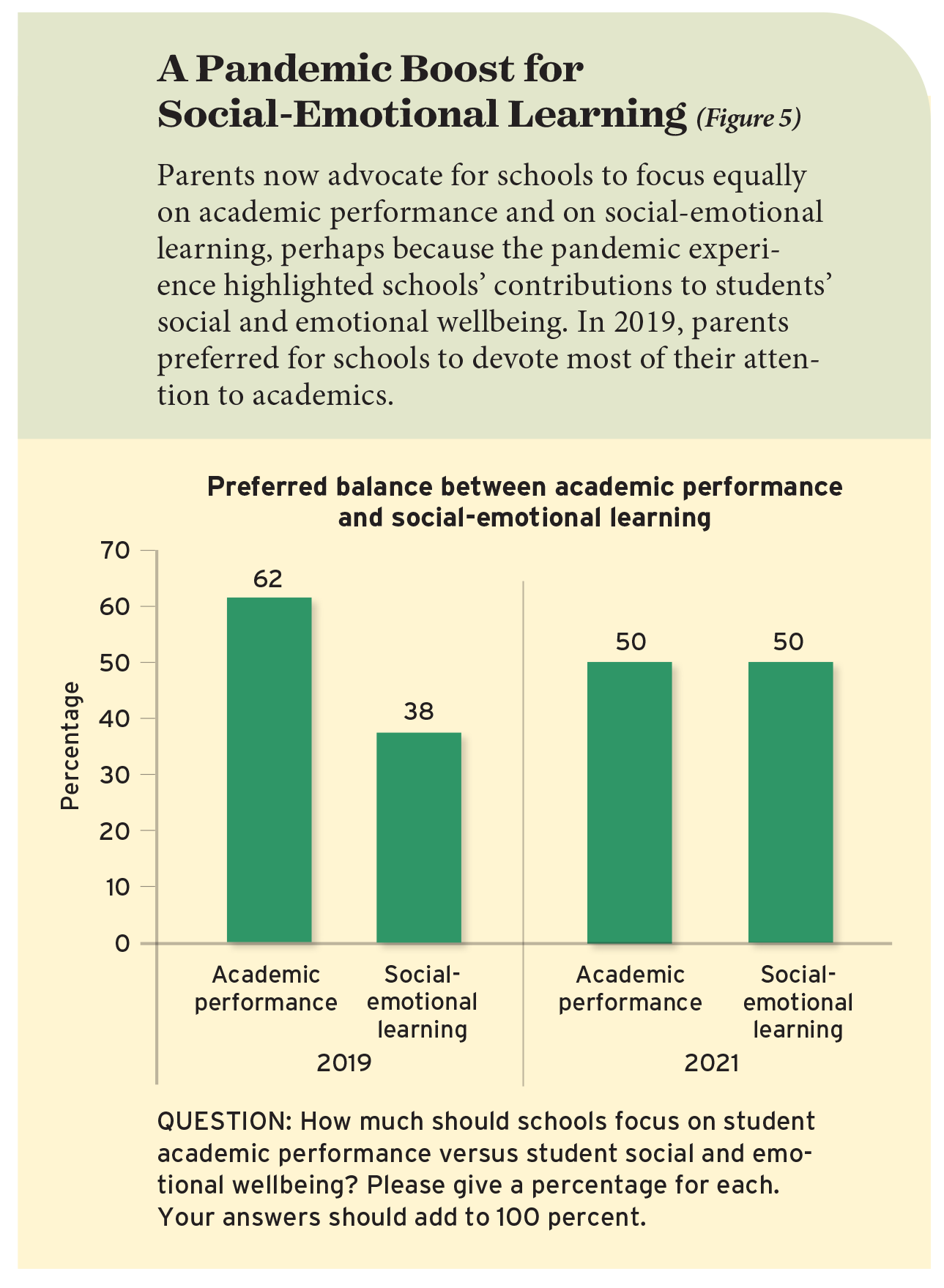
One important shift among parents during the pandemic is their focus on some of the nonacademic aspects of schooling. Back in 2019, we asked survey takers to assign percentages to the amount that schools should “focus on academic performance versus student social and emotional wellbeing.” Among parents, the average response to “academic performance” was 62%, compared to 38% for “social and emotional wellbeing.” Two years later, parents now advocate for a 50–50 split between the two (see Figure 5). It appears that after a particularly challenging school year, parents are more attuned to schools’ potential contributions to students’ nonacademic needs.
One might think parents would become increasingly unhappy as the year progressed without seeing much improvement in their child’s academic, social, emotional, or physical wellbeing. But the percentage of children whose parents say they were “very satisfied” or “somewhat satisfied” with “the instruction and activities provided” by their child’s school increased slightly, from 73% to 78%. It appears that a large majority of parents continue to believe that their children’s schools are doing the best they can under extremely adverse circumstances.
In Short: Although parents continue to report severe negative impacts of school measures taken in response to the pandemic, especially for children not attending school in person, they still express satisfaction with their child’s school, even after a full year or more of disrupted education.
Sector enrollments. In another sign of return to normalcy, the size of each of the four school sectors—district, private, charter, and home-school—has largely returned to the level reported by parents in spring 2020. In November 2020, the size of the district sector appeared to be declining, as parents reported shifting to charter, private, and home-schooling options. That finding seems to have been a short-term aberration that might be related to parents’ uncertainty as to how to identify a child’s school sector during the pandemic, in the absence of in-person school attendance. Our survey data are subject to sampling error, which can be substantial when the sector is small, as are the private, charter, and home-schooling sectors, so all estimates remain somewhat uncertain. However, enrollment in the district sector, which comprises approximately 80% of all students, can be estimated within a 3-percent margin of error. And results for all four sectors show a consistent “return to normalcy” pattern.
Specifically, the share of students reported by parents to be attending schools in the district sector declined by 9 percentage points (to 72% from 81% of total enrollments) between spring and fall 2020. But by June 2021, the end of the school year, the percentage of students in the district sector climbed back up to 79%, not significantly different from the 81% level in spring 2020. Enrollments in the other sectors also returned to much the same levels reported in spring 2020: Private-sector enrollments rose to 11% from 8% of total enrollments between spring and fall 2020, but they returned to the 8% level by spring 2021. Charter enrollments, which had increased to 8% from 5% between spring and fall 2020, fell back to 6%; and the share of students whose parents say they are being schooled at home, which had increased to 8% from 6% of all enrollments between spring and fall 2020, returned to the 6% level in spring 2021.
These home-school estimates differ from the 3% calculated in 2019 by the U.S. Department of Education and the 11% estimated by the U.S. Bureau of the Census in 2020. Our figure of 6% is a “Goldilocks” estimate that falls in between those from the two government agencies. In our survey, when parents indicated that their child was being home-schooled, we offered them the chance to clarify their answer. Some indicated that their child is “enrolled in a school with a physical location but is learning remotely at home.” We did not categorize these students as being home-schooled, which may help explain the differences between the two federal estimates and our own.
In Short: The shares of children attending school in the district, charter, private, and homeschooling sectors showed little change between May 2020 and June 2021. The apparent migration away from the district to the other sectors observed in our November 2020 survey may have been in response to school disruptions in 2020 or to uncertainties that arose when parents were asked about their child’s school at a time when children were learning online from their home.
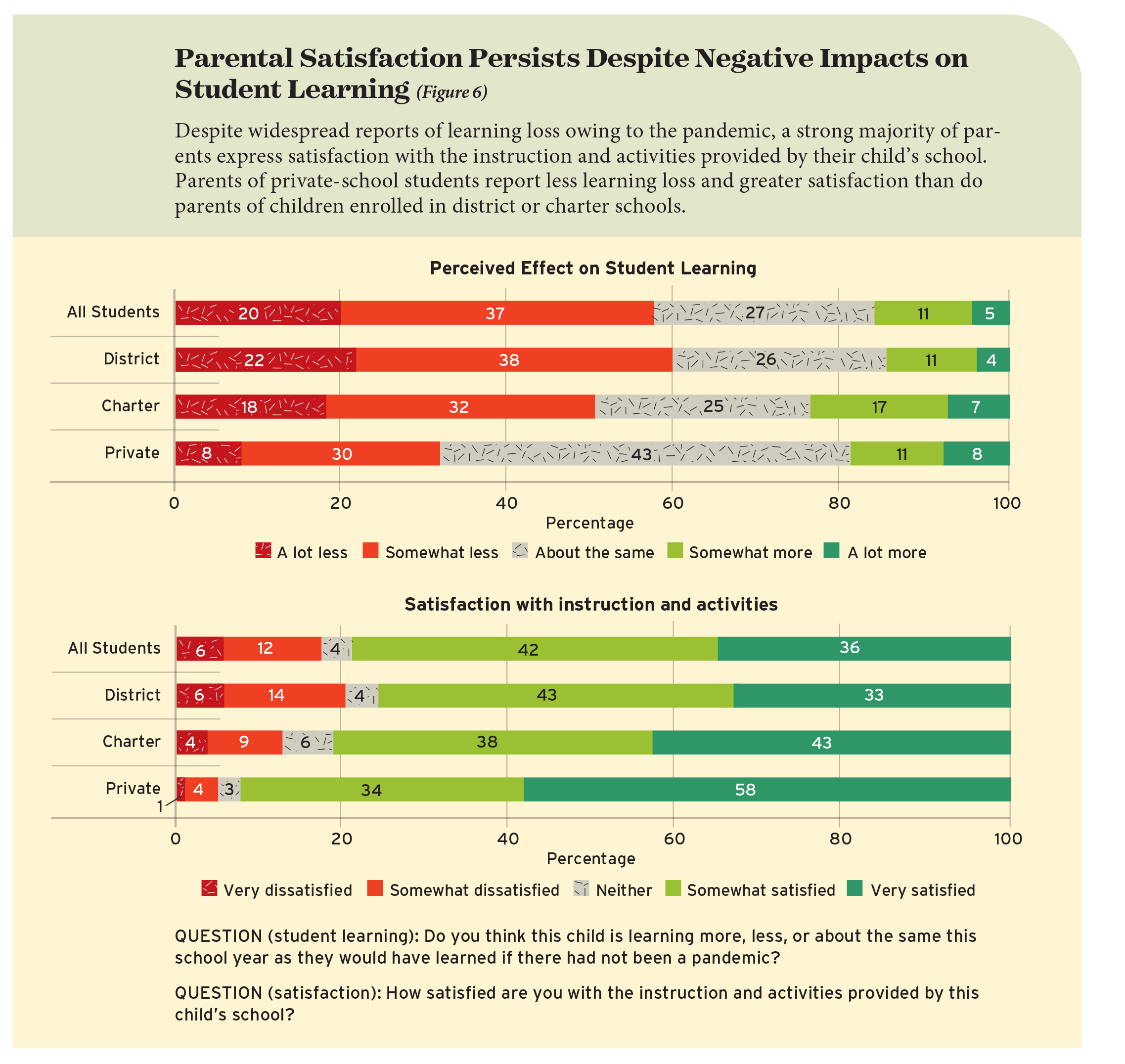
Sector differences. Differences in students’ experiences between the district, charter, and private-school sectors, however, persisted along much the same lines between November 2020 and June 2021. The percentage of children in private school who were said to be attending full-time in-person classes climbed to 79% by the end of the school year, from 60% in November. At district schools, that percentage rose to 50% from 24%; at charters, to 36% from 18%. The percentage of private-school students taught remotely declined to just 8% from an already low 18%. At district schools, the percentage receiving all instruction remotely fell to 28% from 57%; in the charter sector, it drops to 43% from 66%. In other words, in-person learning became increasingly common across all three sectors, but differences persisted: Students attending private schools came back to the school door more rapidly than students at either district or charter schools, as reported by parents in November, a difference that continued until spring. Also, children at charters were more likely to learn remotely than children at district schools in both November and June.
The greater incidence of in-person instruction in private schools as compared to district schools may account for sector differences in parental assessments of their children’s experiences. Thirty-eight percent of children attending private schools suffered learning losses, parents say in June, but that percentage rises to 60% if the child attended public school and 51% if the child was in a charter school (see Figure 6). Similarly, measures taken “to limit the spread of Covid-19” had a less adverse effect on students’ academic knowledge and skills for children attending private schools, parents say (see Figure 7). Of the private-school children, 23% are reported to have suffered somewhat or strongly negative effects from these measures, while the corresponding figure for those attending district schools is 42%. Parents indicate that 28% of students attending charter schools suffered negative impacts on their academic knowledge despite the relatively low incidence of in-person instruction. Either charter schools mounted a better remote educational experience or charter parents were more optimistic in their assessments.
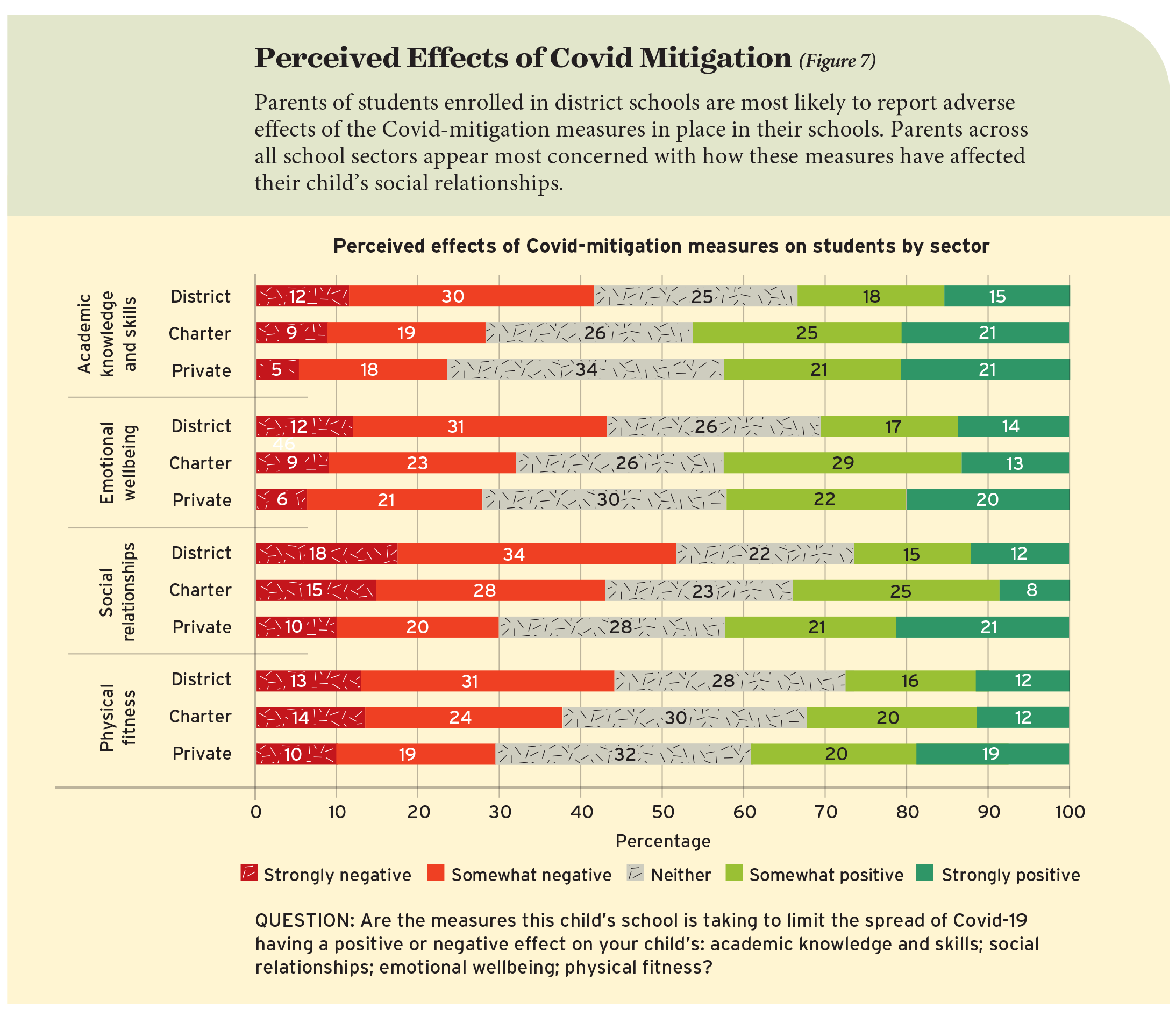
The perceived differences across sectors of the effects of Covid-mitigation measures on social relationships were even greater. Parents report that these measures had negative impacts for 30% of the children in private school but for 52% of those in district schools and 43% of those in charter schools. The measures took their toll on the emotional wellbeing of 28% of children at private schools and 32% of those at charters, but 43% of those at district schools, parents say. When it comes to physical fitness, these percentages are 29%, 38%, and 44% for the three sectors, respectively.
Despite all these negatives, parents across all sectors register a high level of satisfaction with the instruction and activities provided by their child’s school during the pandemic year. No less than 76 percent of district-school children had an experience that caused their parents to feel somewhat or very satisfied, a percentage that rose to 92% and 81% for children attending private and charter schools, respectively.
In Short: According to their parents, a smaller share of children attending private schools, as compared to those attending district schools, are suffering adverse effects on their academic, social, emotional, and physical wellbeing as a result of school measures taken in response to the pandemic. The share of charter-school students reported by their parents to be suffering these effects falls somewhere in between those of children in the district and private-school sectors.
Michael B. Henderson is associate professor of political communication and director of the Public Policy Research Lab at Louisiana State University’s Manship School of Mass Communication. David M. Houston is assistant professor at the College of Education and Human Development at George Mason University. Paul E. Peterson is the Henry Lee Shattuck Professor of Government at Harvard University, director of Harvard’s Program on Education Policy and Governance, and senior editor of Education Next. Martin West is academic dean and Henry Lee Shattuck Professor of Education at the Harvard Graduate School of Education and editor-in-chief of Education Next.
More from the 2021 Education Next survey: “Hunger for Stability Quells Appetite for Change: Results of the 2021 Education Next Survey of Public Opinion“
This article appeared in the Winter 2022 issue of Education Next. Suggested citation format:
Henderson, M.B., Houston, D.M., Peterson, P.E., West, M.R. (2022). Parent Poll Reveals Support for School Covid-Safety Measures Despite Vaccine Hesitancy, Partisan Polarization: Private-school parents report less learning loss, greater satisfaction with pandemic schooling. Education Next, 22(1), 26-36.


